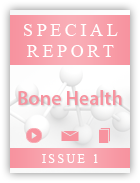Teaching Patients About Bone Health in Breast Cancer
Most women are aware that bone density frequently decreases with age and natural menopause, but many women do not know that breast cancer treatments can reduce bone density and increase the risk of fracture.
Most women are aware that bone density frequently decreases with age and natural menopause, but many women do not know that breast cancer treatments can reduce bone density and increase the risk of fracture.
A survey conducted in 2010 demonstrated that about two-thirds of patients with nonmetastatic breast cancer did not know that treatment with aromatase inhibitors (AIs) could lead to bone loss; of the patients who were aware, most were not concerned. This contrasts sharply with the vast majority of oncologists who consider bone loss to be a serious issue related to AI therapy.1
To meet this awareness gap, information aimed at educating patients about bone health in breast cancer is available in a variety of forms, including Web sites, podcasts, forums, video clips, and downloadable fact sheets and reports.
Web sites that explain risk factors, describe cancer treatment-induced bone loss (CTIBL), and suggest lifestyle modifications and potential treatment for bone loss include:
National Institutes of Health:
What Breast Cancer Survivors Need to Know About Osteoporosis
BreastCancer.org:
Bone Health
WebMD:
Breast Cancer and Osteoporosis
Hormone Health Network:
Breast Cancer and Bone Loss
Imaginis Women’s Health Resource:
Bone Health
Breast Cancer Care:
Osteoporosis and Breast Cancer Treatment- Also available is a16-page fact sheet
Another important factor regarding bone health is that metastases are common in breast cancers, and circulating breast cancer cells have particular affinity for bone. Optimum bone health may reduce skeletal complications and bone pain.2 Sources with information addressing metastases and bone complications include these Web sites and downloadable documents:
Imaginis Women’s Health Resource:
Bone Fractures in Cancer Patients and Survivors
Breast Cancer Care:
Bisphosphonates Fact Sheet
The Bone and Cancer Foundation’s document, “Questions & Answers About Breast Cancer, Bone Metastases, and Treatment-Related Bone Loss,” is a 10-page document that concisely covers a number of topics. These include the relationship between breast cancer and bone health, the risk of breast cancer returning (and location), decreasing the chance of cancer spreading to bone, and treatment-related concerns. It isavailable here.
Another patient educational document describes in more detail the significance of bone health in patients with breast cancer, aiming to improve communication between patients and health care providers about bone health. The 28-page report sponsored by Amgen, “Bone Health In Focus,” starts by describing the 2 primary bone conditions related to breast cancer, CTIBL and bone metastasis. The report reviews current treatments for CTIBL, including calcium plus vitamin D supplements and the use of bisphosphonates, as well as treatment for bone metastases and skeletal-related events in patients with breast cancer. The Web site for this document ishere.
Forums allow participants to connect with others to ask questions and respond to posts about bone health in cancer. Some of these include:
BreastCancer.org:
Forum: Bone Health and Bone Loss
CancerCare.org has a discussion section for participants to submit questions to an expert. The site also provides a searchable archive of previous answers to questions and isavailable here.
Tips on Bone Health
- Several treatments are known to increase the risk of fractures, including ovarian suppression/ablation, aromatase inhibitors, androgen-depletion therapy, and long-term corticosteroids.
- Steps to prevent bone loss
- Baseline fracture risk assessment
- Bone mineral density (BMD) measurement
- Lifestyle modifications:
- Weight-bearing exercise
- Stop smoking
- Reduce alcohol consumption
- Dietary guidelines
- Calcium 1000 mg/day
- Vitamin D 1000-2000 U/day
- Bone-directed antiresorptive therapy (suggested for patients with low BMD or rapid bone loss)
CancerCare.org also offers free 1-hour workshops (accessed by telephone or online as a Webcast) featuring oncology experts who provide up-to-date information. Scheduled for January 28, 2015, is “The Latest Developments Reported at the 37th Annual San Antonio Breast Cancer Symposium.” It can be accessedhere.
Podcasts of previous symposia are available, including a workshop held October 25, 2013, entitled, “Caring for Your Bones When You Have Breast Cancer.” Topics covered are screening for bone health, risk factors, prescription medications, pain control, doctor-patient communication, and the role of nutrition, exercise, and calcium supplements. It isavailable here.
Patients with breast cancer can make the best decisions about their treatment and lifestyle modifications through education. Many resources are available in varying levels of detail to inform patients about bone health and facilitate better communication with health care providers.
References
- Harris Interactive Bone Health Survey. Bone Health In Focus. Amgen Inc. 2010.
- Coleman R, Body JJ, Aapro M, Hadji P, Herrstedt J. Bone health in cancer patients: ESMO Clinical Practice Guidelines.Ann Oncol. 2014;25(suppl 3):iii124-iii137.
